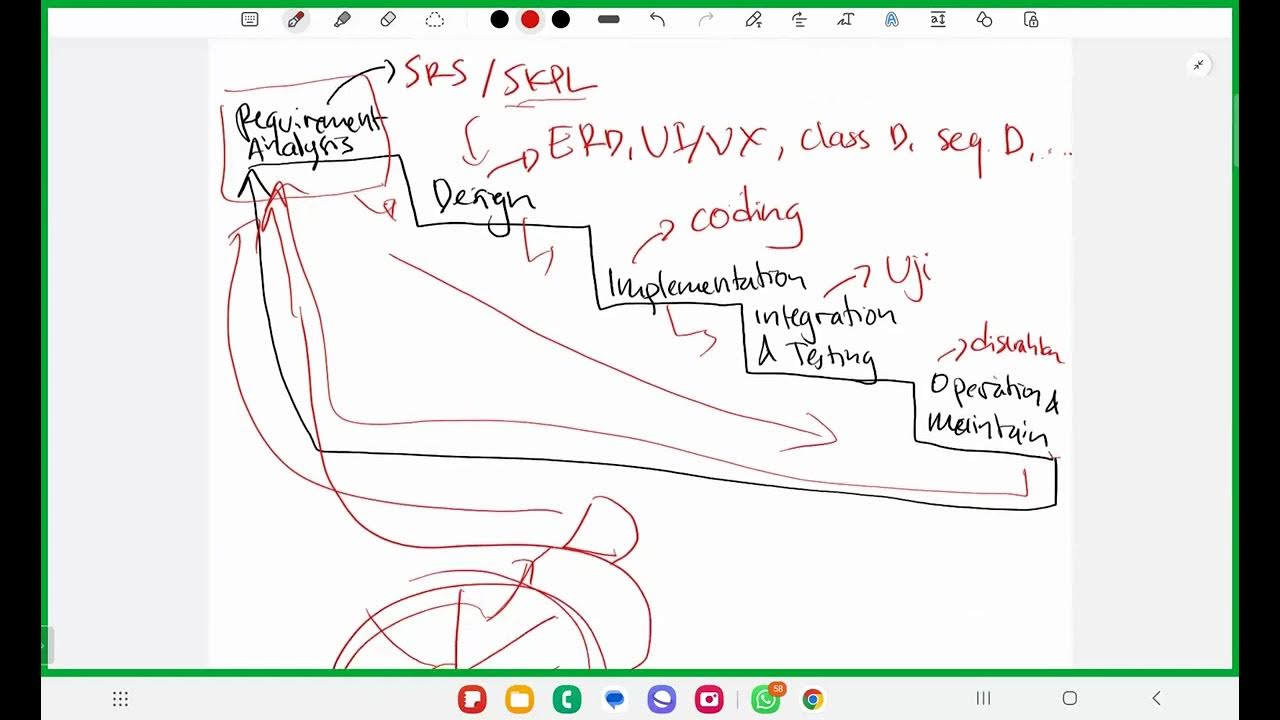Requirements Engineering lecture 2: process
Summary
TLDRThis video provides an insightful overview of the software engineering process, highlighting the crucial role of requirements engineering. The speaker outlines the phases of software engineering, starting with requirements elicitation, followed by analysis, documentation, and verification/validation. Emphasizing the iterative nature of the process, the video explains how requirements may evolve and necessitate adjustments at various stages, including design and implementation. The Twin Peaks model is introduced, illustrating the interplay between requirements and design decisions at multiple system levels, underscoring the complexity and importance of thorough requirements engineering in delivering successful software projects.
Takeaways
- 😀 Software engineering consists of several phases: requirements engineering, design, implementation, testing, deployment, and maintenance.
- 🔍 Requirements engineering is crucial and is often seen as the foundation of the software development process.
- 📝 The process of requirements engineering includes four main phases: elicitation, analysis, documentation, and verification/validation.
- 🤝 Requirements elicitation involves communicating with stakeholders to gather their needs and constraints.
- ⚖️ Requirements analysis focuses on ensuring the gathered requirements are consistent and do not conflict with each other.
- 📄 Documentation is essential for capturing the requirements in a formal manner that can be validated by stakeholders.
- ✅ Verification asks if the requirements were captured correctly, while validation ensures that the right requirements were gathered.
- 🔄 Feedback loops are integral to the software engineering process, allowing for adjustments and refinements at various stages.
- 🚗 The Twin Peaks model illustrates the iterative relationship between requirements gathering and design decisions throughout the development process.
- 🌟 All models in software engineering are simplifications and should be tailored to suit the specific needs of a project.
Q & A
What is the first phase of the software engineering process?
-The first phase of the software engineering process is requirements engineering.
What are the main phases of requirements engineering?
-The main phases of requirements engineering are requirements elicitation, requirements analysis, requirements documentation, and requirements verification and validation.
What does requirements elicitation involve?
-Requirements elicitation involves asking stakeholders for their wishes and constraints to understand their needs.
What is the purpose of requirements analysis?
-The purpose of requirements analysis is to evaluate the set of requirements for consistency and to identify any contradictions.
How does requirements documentation help in the software development process?
-Requirements documentation helps by providing a written record of the understood requirements that stakeholders can review and approve.
What is the difference between verification and validation in requirements engineering?
-Verification ensures that the requirements are accurately recorded, while validation confirms that the requirements meet the actual needs of the stakeholders.
What does the term 'feedback loops' refer to in the software engineering process?
-Feedback loops refer to the process of returning to earlier phases (like requirements engineering) to make adjustments based on findings from later phases (like testing or design).
What is the significance of Al Davis's quote about models?
-Al Davis's quote emphasizes that while models are abstractions and may not capture all details, they are useful tools for understanding complex processes.
What is the Twin Peaks model in requirements engineering?
-The Twin Peaks model illustrates the iterative relationship between requirements and design decisions, emphasizing that both aspects must be continuously refined as the project develops.
Why is it important to address conflicts in requirements?
-It is important to address conflicts in requirements because unresolved conflicts can lead to project failures, budget overruns, or misaligned stakeholder expectations.
Outlines

This section is available to paid users only. Please upgrade to access this part.
Upgrade NowMindmap

This section is available to paid users only. Please upgrade to access this part.
Upgrade NowKeywords

This section is available to paid users only. Please upgrade to access this part.
Upgrade NowHighlights

This section is available to paid users only. Please upgrade to access this part.
Upgrade NowTranscripts

This section is available to paid users only. Please upgrade to access this part.
Upgrade NowBrowse More Related Video

RPL - 01 Pengenalan Rekayasa Perangkat Lunak

What is software engineering? - 1| Software engineering in telugu

O que é Engenharia de Requisitos // Engenharia de Software #01

Resume 5 Model Pengembangan Perangkat Lunak

UNIT OPERATION AND PROCESSES IN ENVIRONMENTAL ENGINEERING

Requirements of Oppression - 2021 IEEE International Requirements Engineering Conference
5.0 / 5 (0 votes)